UPSC Daily Current Affairs: 10th October 2024 | Current Affairs & Hindu Analysis: Daily, Weekly & Monthly PDF Download
GS3/Science and Technology
What is the Marburg Virus?
Source: Indian Express
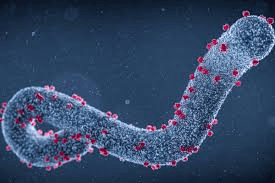
Why in News?
Rwanda has reported a Marburg virus outbreak with several confirmed cases and deaths, making it a country of concern for public health.
About the Marburg Virus
- The Marburg virus is a highly dangerous pathogen that leads to Marburg Virus Disease (MVD), also referred to as Marburg Hemorrhagic Fever.
- This virus is part of the filovirus family, which also includes the Ebola virus.
- The case fatality rate for Marburg virus can vary significantly, ranging from 24% to 88%, depending on the strain of the virus and the management of the cases.
- The virus was first identified in 1967 during simultaneous outbreaks in Frankfurt, Germany, and in Marburg, Germany.
How does it spread?
- The virus primarily spreads from animals to humans, particularly through contact with Rousettus bats, especially the Egyptian fruit bat, which can be found in caves or mines.
- Once a person is infected, the virus can spread between humans through:
- Direct contact with the blood and bodily fluids (such as urine, saliva, sweat, vomit, feces, breast milk, and semen) of an infected individual.
- Indirect contact with contaminated surfaces or objects, including bedding and clothing that have been soiled with these fluids.
- Medical personnel are often at heightened risk during outbreaks, particularly if proper infection control practices are not adhered to.
- The virus does not transmit through the air like more common viruses, such as the cold or flu.
Symptoms and Treatment
- Symptoms typically manifest within 2 to 21 days following exposure to the virus.
- Initial symptoms include:
- High fever
- Severe headache
- Muscle aches
- Chills
- Severe watery diarrhea
- Abdominal pain and cramping
- Nausea and vomiting
- As the disease advances, more severe symptoms may occur, such as:
- Bleeding, which can be both internal and external (for example, blood in vomit and feces).
- Patients often succumb to the disease 8 to 9 days after symptoms begin, primarily due to severe blood loss and multiple organ failure.
- Currently, there are no approved vaccines or specific antiviral treatments for Marburg Virus Disease. However, supportive care can enhance survival rates.
- Supportive treatment may involve:
- Rehydration, using either oral or intravenous fluids, to maintain fluid and electrolyte balance.
- Treating specific symptoms, which may include blood transfusions and oxygen therapy for severe cases.
PYQ:
[2015] Among the following, which were frequently mentioned in the news for the outbreak of Ebola virus recently?
(a) Syria and Jordan
(b) Guinea, Sierra Leone and Liberia
(c) Philippines and Papua New Guinea
(d) Jamaica, Haiti and Surinam
GS3/Science and Technology
What is Rice Fortification?
Source: Indian Express

Why in News?
The Union Cabinet has decided to prolong the universal supply of fortified rice across all central government programs that provide free food grain under the National Food Security Act, 2021, until December 2028.
About Rice Fortification:
- Fortification involves the addition of Fortified Rice Kernels (FRK), which include micronutrients prescribed by FSSAI, such as Iron, Folic Acid, and Vitamin B12, to regular rice at a ratio of 1:100 (1 kg of FRK mixed with 100 kg of custom milled rice).
- Fortified rice maintains a similar aroma, taste, and texture to traditional rice. This fortification process occurs at rice mills during the milling stage.
- This method is a cost-effective and culturally suitable approach to mitigate micronutrient deficiencies in regions with high rice consumption.
- Rice fortification consists of two main steps:
- Production of Fortified Rice Kernels (FRK)
- Blending of regular rice with FRK
- Various techniques for rice fortification include coating, dusting, and extrusion. Extrusion is the most effective technology used in India.
- The process begins with dry rice flour mixed with a micronutrient premix, followed by the addition of water. This mixture is then processed through a twin-screw extruder equipped with heating zones.
- This process produces kernels that closely resemble regular milled rice in size and shape.
- After production, the kernels are dried, cooled, and packaged. FRK has a shelf life of at least 12 months.
- These kernels are then blended with standard rice, following the Ministry's guidelines, which stipulate that 10 grams of FRK must be combined with 1 kilogram of regular rice.
- According to FSSAI standards, 1 kilogram of fortified rice will typically contain:
- Iron: 28 mg - 42.5 mg
- Folic Acid: 75 - 125 micrograms
- Vitamin B-12: 0.75 - 1.25 micrograms
GS2/International Relations
IBSAMAR VIII
Source: Financial Express
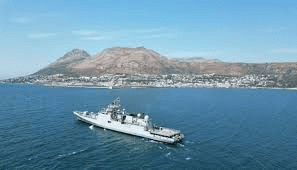
Why in News?
Indian Navy’s frontline stealth frigate, INS Talwar, has arrived at Simon’s Town, South Africa, to take part in the eighth edition of the IBSAMAR exercise.
About
- This exercise is a joint multinational maritime drill involving the navies of India, Brazil, and South Africa.
- The primary objective is to enhance interoperability and strengthen collaboration among the three nations' navies.
- The exercise focuses on Blue Water Naval Warfare, which includes various aspects such as Surface and Anti-Air Warfare.
- The harbour phase of IBSAMAR VIII will feature:
- Professional exchanges between the navies.
- Damage Control and Firefighting drills.
- Visit, Board, Search, and Seizure (VBSS) drills.
- Cross-boarding exercises.
- Aviation safety lectures.
- Joint diving operations.
- Ocean Governance seminar.
- Sports interactions to foster camaraderie.
- Cross-deck visits for enhanced learning and cooperation.
- Interactions among Special Forces and Junior Officers to build teamwork.
Significance:
- Multilateral interactions serve as vital links of friendship, enhancing mutual trust among navies of like-minded coastal nations.
- The common goal is to promote a peaceful maritime domain and foster a positive maritime environment.
- INS Talwar was commissioned on June 18, 2003, and is part of the Indian Navy’s Western Fleet, which is based in Mumbai under the Western Naval Command.
- The visit of INS Talwar aims to reinforce ties and demonstrate India’s commitment to constructive collaboration and mutual growth.
GS3/Economy
What is the Samsung worker’s strike in Chennai about?
Source: The Hindu
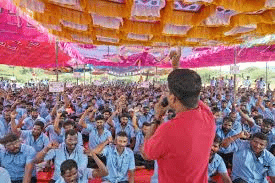
Why in News?
Approximately two-thirds of the workforce at Samsung's main factory in Chennai has been on strike for a month, advocating for improved wages, a standardized eight-hour workday, enhanced workplace conditions, and official recognition of their union.
- Main Demands of the Striking Workers
- Higher Wages: Employees are requesting salary increases to better their financial stability.
- Eight-Hour Work Day: Workers desire the implementation of an eight-hour workday to achieve a better work-life balance.
- Better Working Conditions: Strikers are calling for enhancements in health and safety standards within the workplace.
- Recognition of Labour Union: The workers seek formal acknowledgment of their newly established union, the Samsung India Workers Union (SIWU).
Samsung's Union Policy
Historically, Samsung has enforced a strict no-union policy for over 80 years, resisting any attempts at collective bargaining by employees. However, in July 2021, the company began to acknowledge unions following successful negotiations at Samsung Display and Samsung Electronics, allowing some level of collective bargaining. Currently, Samsung has various unions representing its global workforce, particularly in South Korea.
Challenges Faced by SIWU
- Registration Challenges: The SIWU's registration has faced opposition from Samsung management, which cites trademark issues due to the union's use of the name "Samsung".
- Legal Precedents: SIWU contends that trademark concerns are irrelevant as their activities do not involve commercial operations that would infringe on the trademark.
- Pending Legal Review: The registration status of SIWU is currently under judicial review as the government assesses the objections raised by Samsung management.
Government Response
- Indifferent Stance: SIWU and the Centre of Indian Trade Unions (CITU) have criticized the Tamil Nadu government for appearing indifferent and favoring Samsung management, a claim the government refutes.
- Support for Workers’ Rights: The government asserts it is considering the registration application while addressing Samsung's objections to ensure fair treatment for both workers and management.
- CITU’s Position: Union leaders argue that government actions favoring management compromise workers' rights and may hinder unionization efforts, despite evidence illustrating that unions can be beneficial for both employees and companies.
Current Legislation in India
- Notice Period and Conditions for Strikes: According to the Industrial Relations Code, 2020, workers must provide a 14-day notice before initiating a strike, which can last up to a maximum of 60 days.
- Definition of Strike: The definition of a strike now encompasses "mass casual leave," where if over 50% of employees take leave, it can be classified as a strike.
- Increased Flexibility for Employers: The code has raised the threshold for layoffs from 100 to 300 workers, permitting companies to lay off employees without needing government approval. This change aims to provide greater operational flexibility for employers, but it has raised concerns among labor unions about job security and workers’ rights.
Way Forward
- Facilitate Dialogue and Mediation: Establish a formal dialogue among workers, Samsung management, and government representatives to address grievances, negotiate demands, and seek a mutually agreeable solution.
- Strengthen Legal Framework for Union Recognition: Amend or clarify existing labor laws to ensure timely and transparent processes for union registration, protecting their rights and enabling effective collective bargaining.
GS3/Economy
Monetary Policy Committee Meeting 2024
Source: Indian Express
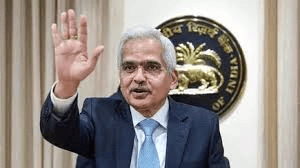
Why in news?
The Reserve Bank of India (RBI) announced its fourth bi-monthly monetary policy for FY25 on October 9, 2024. The RBI's Monetary Policy Committee (MPC) decided to maintain the repo rate at 6.5%, marking the tenth consecutive time this rate has remained unchanged. A majority of five out of six MPC members supported this decision.
Current domestic and global situation
- Domestic economic growth is robust, and the global economy is recovering since the last MPC meeting.
- However, challenges persist due to geopolitical tensions, instability in financial markets, and elevated public debt levels.
- On a positive note, there are indications of recovery in world trade.
Key highlights of the MPC meeting
- The repo rate remains at 6.50%, which is the rate at which the RBI lends to commercial banks during cash shortages.
- The standing deposit facility (SDF) is set at 6.25%, allowing banks to park excess liquidity without needing to provide collateral.
- The marginal standing facility (MSF) rate is 6.75%, used by banks in emergencies when inter-bank liquidity is tight.
- The bank rate is also 6.75%, which is the rate charged by the RBI for lending to commercial banks.
The Committee
- Established under Section 45ZB of the amended RBI Act, 1934, the MPC consists of six members.
- The members include the RBI Governor (Chairperson), the Deputy Governor responsible for monetary policy, a Bank officer nominated by the Central Board, and three members appointed by the central government.
Functions of MPC
- Setting Policy Interest Rates: The MPC's main role is to decide on policy interest rates like the repo rate.
- Inflation Targeting: The government has set an inflation target of 4%, with a permissible variation of +/- 2%.
- Economic Analysis and Forecasting: The Committee conducts in-depth analyses of economic indicators such as inflation, GDP growth, and employment.
- Decision-Making: The MPC convenes at least four times a year to assess and adjust monetary policy.
Current domestic and global situation against which the MPC meeting was held
- Domestic growth is strong, and the global economy is resilient since the last MPC meeting.
- Risks from geopolitical conflicts and financial market instability remain, but there are signs of world trade recovery.
Policy stance changed
- The RBI shifted its policy stance from 'Withdrawal of Accommodation' to 'Neutral'.
- 'Withdrawal of Accommodation' involves reducing the money supply to control inflation, making rate cuts unlikely.
- 'Neutral' stance indicates the RBI's willingness to adjust rates based on inflation and economic growth data.
GDP projection
- India's real GDP grew by 6.7% in Q1 of FY25.
- The RBI maintains its GDP growth projection at 7.2% for the fiscal year.
Inflation projection
- The MPC projects inflation at 5% for FY25, consistent with previous forecasts.
- Headline inflation dropped significantly to 3.6% in July and 3.7% in August from 5.1% in June.
- However, September inflation may rise due to base effects and higher food prices, although food inflation is expected to decrease by Q4 FY25.
- Core inflation is anticipated to remain stable, influencing the RBI's neutral policy stance.
- Risks such as adverse weather, geopolitical issues, and rising costs of food and metals could elevate inflation in the near future.
Reserve Bank Climate Risk Information System (RB-CRIS)
- The RBI plans to establish the RB-CRIS to improve access to climate-related data.
- This system will include a public web-based directory of data sources and a data portal with standardized datasets for regulated entities.
Enhancement of transaction and wallet limits for UPI
- UPI Lite Wallet Limit Increased: The limit for UPI Lite wallets has been raised from Rs 2,000 to Rs 5,000, and per transaction limits from Rs 500 to Rs 1,000.
- UPI123 Pay Transaction Limit Enhanced: The per-transaction limit for UPI123 Pay has been increased to ₹10,000 from ₹5,000, now accessible in 12 languages.
- Beneficiary Account Name Look-up Facility: A new feature for RTGS and NEFT transactions allows users to confirm beneficiary names by entering account numbers and IFSC codes.
- Foreclosure Charges on MSE Loans Removed: The RBI has prohibited foreclosure charges and pre-payment penalties on loans to micro and small enterprises (MSEs) to ensure transparency and customer-friendly lending practices.
GS3/Environment
Mount Dhaulagiri
Source: Times of India

Why in News?
Recently, five Russian mountaineers tragically lost their lives while attempting to summit Mount Dhaulagiri, the seventh-highest peak in the world, located in Nepal.
About
- Details
- Location: Situated in north-central Nepal within the Dhaulagiri Himal range.
- Name Origin: The term "Dhaulagiri" is derived from the Sanskrit words "dhawala" (meaning white or dazzling) and "giri" (meaning mountain).
- Mountain Range: Dhaulagiri Himal is part of the broader Nepal Himalayas.
- Elevation: The peak stands at 8,167 meters (26,795 feet).
- Prominence: It has a prominence of 3,357 meters (11,014 feet).
- First Ascent: The mountain was first successfully ascended on May 13, 1960, by a combined expedition of Swiss, Austrian, and Nepalese climbers.
- Nearby River: The Kali Gandaki River flows through the gorge that separates Dhaulagiri from the Annapurna range.
- Glaciers: Notable glaciers in the region include the Chonbardan Glacier and the Myagdi Glacier.
- Climate & Conditions: Climbers face extreme cold, high winds, and unpredictable weather conditions, making expeditions challenging.
GS3/Environment
Caracal
Source: Indian Express

Why in News?
Recently, the Gujarat government has announced the establishment of a Caracal (Henotaro) Breeding and Conservation Center in the Chadva Rakhal region of Kutch, with a budget allocation of ₹10 crore.
About
- Caracal is a secretive and mostly nocturnal species known for its agility and remarkable skill in catching birds mid-flight.
- In India, it is referred to as 'siya gosh,' a term derived from Persian meaning 'black Ear.'
- These animals utilize abandoned burrows of porcupines and rocky crevices for nesting but can often be found with their young in lush vegetation.
- Caracals tend to live in small groups, yet their timid and elusive nature makes them hard to observe in their natural habitat.
Habitat
- Caracals are found in various ecosystems including woodlands, savannahs, and scrub forests.
Distribution
- In India, the most suitable environments for caracals include regions in Rajasthan, Gujarat, and Madhya Pradesh, notably in Kutch, the Malwa Plateau, the Aravalli hill range, and the Bundelkhand region.
- Globally, caracals inhabit numerous countries across Africa, the Middle East, Central Asia, and South Asia.
Threats
- The species faces significant dangers from extensive hunting, illegal wildlife trade, and the degradation of their natural habitats.
Conservation status
- IUCN: Listed as Least Concern.
- The Wild Life (Protection) Act, 1972: Classified under Schedule I, indicating it is afforded the highest level of protection.
GS3/Environment
EU’s Carbon Border Adjustment Mechanism
Source: Indian Express

Why in News?
Finance Minister Nirmala Sitharaman has criticized the European Union’s initiatives, such as the Carbon Border Adjustment Mechanism (CBAM) and Deforestation Rules, labeling them as ‘unilateral’ and ‘arbitrary’ measures.
News Summary
The Carbon Border Adjustment Mechanism (CBAM) is a policy initiative introduced by the European Union (EU) aimed at mitigating carbon emissions by imposing a carbon price on imports from nations with less stringent climate regulations. This mechanism ensures that imported goods incur similar carbon costs as those produced within the EU, fostering fair competition and encouraging global efforts towards decarbonization.
Key Features of CBAM:
- Objective: The primary goal of CBAM is to prevent carbon leakage, which occurs when companies relocate production to countries with more lenient carbon regulations to evade strict EU climate policies. It aligns with the EU’s climate objectives, particularly the European Green Deal, which aims for net-zero emissions by 2050.
- Scope: Initially, CBAM targets sectors that significantly contribute to carbon emissions, including cement, steel, aluminum, fertilizers, electricity, and hydrogen. The mechanism calculates the embedded carbon emissions in imported goods and applies an equivalent carbon price.
Implementation Timeline:
- 2023-2025: A transitional phase where importers will report the carbon emissions of their products without incurring the adjustment cost.
- 2026 onward: Full enforcement where importers must buy CBAM certificates corresponding to the embedded carbon emissions of their imports.
Working Mechanism of CBAM:
- CBAM Certificates: Importers are obligated to purchase CBAM certificates to cover the carbon emissions of their imported products, aligning with the EU’s Emissions Trading System (ETS) price. The cost of these certificates will mirror the EU’s internal carbon price, ensuring equitable conditions for both domestic and foreign producers.
- Calculation of Carbon Emissions: The carbon footprint of imported products is assessed based on direct emissions during their production. If a country already implements a carbon price, this can be deducted from the CBAM obligation to avoid double taxation.
Why Developing Countries Like India Find EU’s Deforestation Rules Discriminatory:
The European Union's Deforestation Rules, aimed at curbing the import of products associated with deforestation, have drawn criticism from various developing countries. These nations assert that the rules are discriminatory for several reasons, primarily concerning fairness, trade barriers, and the economic strain of compliance.
- Increased Compliance Costs: The EU regulations mandate exporters to provide geolocation data and demonstrate that commodities such as soy, palm oil, coffee, and cocoa are not sourced from recently deforested areas. Small-scale farmers in developing countries often lack the necessary resources, technology, and expertise to meet these strict requirements, making adherence to these rules both costly and administratively burdensome. This can render their exports less competitive in the EU market.
- Disadvantage to Agricultural Exports: Many developing nations are heavily reliant on agricultural exports identified by the EU as high-risk for deforestation, such as those from Indonesia and Malaysia or various African and Latin American countries. These rules can act as non-tariff barriers, potentially limiting market access for these nations in the EU.
- Limited Recognition of National Efforts: Developing countries feel that the EU's regulations fail to adequately acknowledge their national initiatives to combat deforestation and promote sustainable land-use practices. Countries like India, Brazil, Indonesia, and Ghana have implemented domestic policies and reforestation initiatives but believe the EU’s rules impose a one-size-fits-all standard that disregards these efforts. This perceived lack of recognition undermines their sovereignty in resource management.
- Unequal Responsibility for Climate Change: Developing nations argue that the EU’s deforestation regulations unfairly place a disproportionate burden on them regarding global environmental challenges like deforestation and climate change. Historically, developed countries have been the primary contributors to global carbon emissions and deforestation through industrialization. However, developing countries, often dependent on agriculture for economic development, are pressured to comply with stringent standards that could impede their growth, viewing this as a form of environmental double standards.
GS3/Economy
Universal supply of fortified rice till December 2028
Source: DTE
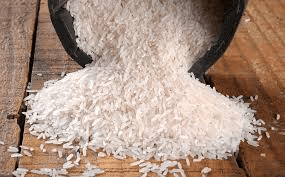
Why in news?
The Union cabinet, led by Prime Minister Modi, has given approval for the ongoing universal supply of fortified rice across all Union government schemes, including the Pradhan Mantri Garib Kalyan Anna Yojana (PMGKAY), starting from July 2024 and continuing until December 2028. This rice fortification effort will be supported entirely by the Centre as part of PMGKAY (Food Subsidy), establishing a cohesive framework for its implementation.
About/definition
The Food Safety and Standards Authority of India (FSSAI) defines fortification as the intentional addition of vital micronutrients to food to enhance its nutritional value and deliver public health advantages while posing minimal health risks.
Need for fortification of rice
- Malnutrition in India:
- India grapples with high malnutrition rates, particularly among women and children.
- The National Family Health Survey (NFHS-5) indicates that a significant portion of the population suffers from anaemia, with one in two women and one in three children being affected.
- There are widespread deficiencies in iron, Vitamin B12, and folic acid, which impact overall health and productivity.
Fortification of Rice as a Solution
- Rice serves as a staple for two-thirds of the Indian population, making it an ideal candidate for fortification to combat malnutrition.
- The average rice consumption per person in India is 6.8 kg each month; fortifying this staple can effectively enhance the nutritional intake of economically disadvantaged groups.
Fortification Process
- Fortification technologies comprise coating, dusting, and extrusion, with extrusion deemed the most appropriate method for India.
- The extrusion process involves mixing dry rice flour with micronutrients and water, then processing it through an extruder to create fortified rice kernels (FRKs) that resemble standard rice.
- These fortified kernels are mixed with regular rice at a ratio of 10g of FRK to 1 kg of rice to yield fortified rice.
Nutrient Content in Fortified Rice
According to FSSAI standards, 1 kg of fortified rice is required to contain:
- Iron: 28 mg to 42.5 mg
- Folic acid: 75 to 125 micrograms
- Vitamin B12: 0.75 to 1.25 micrograms
- It may also include other micronutrients like zinc, vitamin A, and various B vitamins.
Cooking and Consumption of Fortified Rice
Fortified rice can be cooked and consumed just like regular rice, and it maintains its micronutrient content after cooking. The packaging is identifiable by a logo (‘+F’) and labeled as “Fortified with Iron, Folic Acid, and Vitamin B12.”
Progress of the Rice Fortification Initiative
- In 2015, PM Modi declared that rice distributed through government schemes, including the Public Distribution System (PDS) and Mid-Day Meal Scheme, would be fortified by 2024.
- The implementation of this initiative occurs in phases:
- Phase 1: Integrated Child Development Services and PM POSHAN by March 2022.
- Phase 2: PDS and welfare schemes in 112 Aspirational Districts by March 2023.
- Phase 3: Comprehensive nationwide coverage by March 2024.
Cost and Scale of the Initiative
The annual expenditure for rice fortification is approximately ₹2,700 crore, which is less than 2% of India’s total food subsidy budget. From 2019 until March 2024, around 406 lakh metric tonnes of fortified rice have been distributed via the PDS. Currently, there are 925 fortified rice manufacturers capable of producing 111 lakh metric tonnes annually, while rice mills can blend up to 223 lakh metric tonnes.
The government has allocated ₹11,000 crore to enhance the fortified rice supply chain.
Pradhan Mantri Garib Kalyan Anna Yojana (PM-GKAY)
PM-GKAY is a food security welfare initiative launched by the Central Government in March 2020 in response to the Covid-19 pandemic. It is part of the Pradhan Mantri Garib Kalyan Package (PMGKP) aimed at assisting the underprivileged during this crisis.
Objective
- The primary goal is to provide food aid to India’s poorest citizens through the Public Distribution System, ensuring that all priority households (ration card holders and beneficiaries of the Antyodaya Anna Yojana) receive grain.
Entitlement
Eligible ration cardholders under the NFSA 2013 are entitled to receive 5 kg of free wheat or rice per person each month, in addition to the 5 kg of food grains already allocated under the National Food Security Act, 2013.
Implementing Agency
The program is overseen by the Department of Food and Public Distribution within the Ministry of Consumer Affairs, Food and Public Distribution.
Merger of PM-GKAY and NFSA
In December 2022, the government merged PMGKAY with the NFSA. After this merger, all beneficiaries received the entire quantity (5 kg and 35 kg) free of charge. This move provided a legal entitlement for the poor to receive 5 kg of food grains at no cost.
Extension of PM-GKAY
This scheme has been extended for an additional five years, commencing January 1, 2024, after its prior extension until December 31, 2023.
The NFSA, 2013, aims to ensure food and nutritional security by guaranteeing access to an adequate quantity of quality food at affordable prices, allowing individuals to live with dignity. It establishes a legal right for individuals belonging to “eligible households” to acquire food grains at subsidized prices through the Targeted Public Distribution System (TPDS).
State governments are responsible for identifying beneficiaries under the Antyodaya Anna Yojana (AAY - the poorest of the poor) and priority households (PHH) within the TPDS population. Each individual in the PHH category receives 5 kg of food grains monthly at the following rates:
- Rice at ₹3/kg
- Wheat at ₹2/kg
- Coarse grain at ₹1/kg
Each Antyodaya Anna Yojana (AAY) household is entitled to 35 kg of food grains monthly. The Act covers up to 75% of the rural population and 50% of the urban population, allowing approximately 67% of the total population to access subsidized food grains.
GS3/Environment
What is Agasthyamalai Bambootail?
Source: New Indian Express
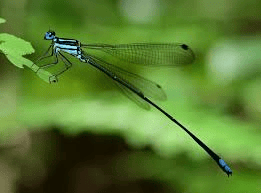
Why in News?
A recent study led to the discovery of a new species of damselfly named Agasthyamalai Bambootail, found in Manjadininnavila, located in the Thiruvananthapuram district of Kerala.
About Agasthyamalai Bambootail:
- Agasthyamalai Bambootail is a newly identified species.
- This species is classified as rare and belongs to the bambootail group.
- The name "bambootail" derives from their elongated cylindrical abdomens that resemble bamboo stalks.
- This damselfly was discovered in the Agasthyamalai region within the Western Ghats.
- Another known species in this genus is the Malabar Bambootail (Melanoneura bilineata), which inhabits the Coorg-Wayanad region.
- Members of this genus can be distinguished from other bambootails because they lack an anal bridge vein in their wings.
- These damselflies are characterized by long black bodies adorned with vibrant blue markings.
- The Agasthyamalai Bambootail differs from the Malabar Bambootail in the structure of the prothorax, anal appendages, and secondary genitalia.
Key Facts about Damselflies:
- Damselflies are predatory aerial insects categorized under the order Odonata.
- They are typically found near shallow freshwater environments.
- These insects are known for their graceful flying abilities, exhibiting slender bodies and long, delicate, net-veined wings.
- Compared to dragonflies, damselflies are generally smaller and more delicate, with weaker flight capabilities.
- Their large eyes are distinct in that they are always widely separated, unlike the close-set eyes of dragonflies.
- Damselflies can display remarkably vivid colors.
- The wingspan of the approximately 2,600 species of damselflies varies significantly, ranging from 18 mm (0.71 inches) to about 19 cm (7.5 inches) in the case of the Megaloprepus caerulatus, a giant damselfly found in tropical Central and South America.
- Immature damselflies, referred to as larvae (or occasionally nymphs or naiads), are primarily aquatic predators inhabiting freshwater ecosystems.
|
38 videos|5293 docs|1118 tests
|
















